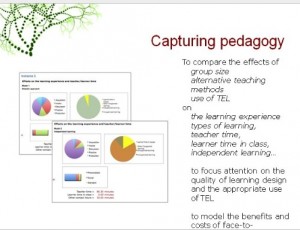This morning I spent an hour catching up with seminar given last week by the LDSE team gave as part of a series of online seminars being run by the Curriculum Design and Delivery support project. You can view the session by following the link at the bottom of this page.
The LDSE (Learning Design Support Environment) is an ESRC/EPSRC TEL funded project involving the Institute of Education, Birkbeck College, University of Oxford, London Metropolitan University, London School of Economics and Political Science, Royal Veterinary College and ALT. The project builds on the work of previously JISC funded projects Phoebe and LPP and aims to discover how to use digital technologies to support teachers in designing effective technology-enhanced learning (you can read more on the project summary page or watch this video).
The are a number of overlapping interests with the LDSE and the current JISC funded Curriculum Design programme and the session was designed to give an overview of the system and an opportunity to discuss some common areas such as: how to model principles in educational design, guidelines and toolkits for staff, joining up systems and how do we join up institution-level business processes with learning-level design?
During the tour of the system Marion Manton explained how the system underpinned by an learning design ontology to help enhance the user experience. So the system is able to “understand” relationships of learning design properties (such as teaching styles) and provide the user with analysis of and different views of the pedagogical make-up of their design/learning experience.

LDSE pedagogy pie chart
The system also allows for a timeline view of designs and which again is something practitioners find very useful. There is some pre-population of fields (based on the ontology) but these are customizable. Each of the fields also links to further guidance and advice based on the Phoebe wiki based approach.
The ontology was created using Protégé and the team will be making the latest version of the ontology publicly available through the Protege sharing site.
I think the ontology based approach, the different views it provides, and the guidance the system gives are all major steps forward in terms of developing useful tools to aid practitioners in the design process. I know when I gave a very short demo of the LDSE at a seminar in my department a couple of weeks ago, there was real sense of engagement from staff. However in terms of joining up systems and integrating a tool like the LDSE into wider institutional systems and processes I did feel that there was something missing.
The team did point out that the system can import and export xml, but I’m still unclear exactly how/where/what a system would do with the xml from LDSE. How could you make it into either a runnable design in your VLE or indeed be able to be used as an “official” course document either in a course approval process or in a course handbook or both? One of the final outputs CETIS produced for the Design for Learning Programme was a mapping of programme outputs to IMS LD, and we were able to come up with a number of common field, this could be a starting point for the team.
There was some discussion about perhaps integrating XCRI, however the developers in the session didn’t seem to be familiar with it. And to be fair, why should computer scientists know about a course advertising spec? Probably most teachers and a fair few institutional marketing departments don’t know about it either. This is one area where hopefully the Design Programme and LDSE can share experiences. Most of the design projects are in the process of rolling out new course approval documents so maybe a list of common fields from them could be shared with the LDSE team to help build a generic template. We already know that the XCRI CAP profile doesn’t include the depth of educational information most of the design projects would like to gather. However this is starting to be addressed with XCRI being integrated into the CEN MLO work.
Hopefully the LDSE team will be able to make some in-roads now into allowing the system to produce outputs which people can start to re-use and share effectively with a number of systems. And this has got me thinking about the possibility of the next CETIS Design Bash being based around a number of challenges for import/exporting course approval documents into systems such as LDSE and the systems being used by the Design projects. I’d be really interested in hearing any more thoughts around this.